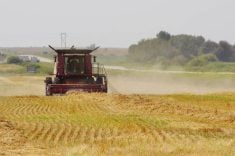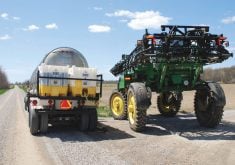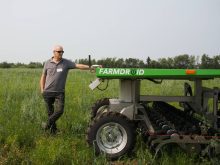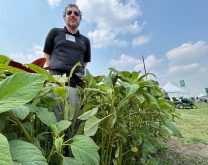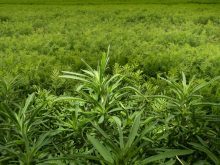WINNIPEG — In the 1970s and early 1980s, Jack Nicholson was a major star in Hollywood. He was the leading man in iconic movies such as The Shining, Chinatown and One Flew Over the Cuckoo’s Nest.
Nicholson was still acting in the 1990s and 2000s, but he had more success as a supporting actor — in movies such as A Few Good Men and The Departed.
Related stories:
That sort of career arc, from star to a member of the supporting cast, is normal in the movie industry.
Read Also

Canadian Food Inspection Agency red tape changes a first step: agriculture
Farm groups say they’re happy to see action on Canada’s federal regulatory red tape, but there’s still a lot of streamlining left to be done
In the agricultural industry, the most popular herbicide on the planet may be destined for a similar fate.
Some weed scientists believe glyphosate will soon play a supporting role on Canadian farms.
Growers will continue to use the herbicide, but only to control the secondary weeds — not the important weeds.
“I think (glyphosate) … will be a complementary herbicide that is added to many other weed management programs,” said Peter Sikkema, a University of Guelph weed scientist who retired earlier this year.
As an example, one of the most troublesome weeds in Ontario is Canada fleabane, a.k.a. horseweed.

A large percentage of horseweed in Ontario has genetic resistance to glyphosate, so growers use other chemistries to control it.
Glyphosate may not kill horseweed or waterhemp — another problematic weed in Ontario’s cropland — but it still controls many other species.
“For that reason, I would suggest that glyphosate in the foreseeable future, I’m not saying indefinitely … will have a fit in terms of weed management in the province of Ontario. It’s still going to control those other weeds that are present,” said Sikkema, who continues to work on weed science projects.
Glyphosate is the generic name for Roundup, which was commercialized 50 years ago by Monsanto.
Hugh Beckie, a former Agriculture Canada researcher in Saskatoon and a global expert in herbicide resistant weeds, summarized what Roundup has meant for farmers in Western Canada and elsewhere in a 2020 paper — Farming without Glyphosate? — published January 2020 in Plants.
“Glyphosate greatly facilitated the adoption of minimum or no-tillage cropping in the late 1970s and 1980s, which enabled greater yields and yield stability, especially in arid to semiarid regions through soil moisture conservation,” Beckie wrote.
“Most importantly, it mitigated the rapid decline in soil quality due to excessive tillage that was prevalent in many global agro-regions up until the 1980s.”
The use of Roundup increased in Western Canada and globally as farmers adopted zero tillage. But after 1996, following the introduction of glyphosate tolerant soybeans, corn, cotton and canola, use of the herbicide exploded.

In 1994, the global use of glyphosate was 56 million kilograms, using data from a 2016 paper by Chuck Benbrook, an American agricultural economist.
In 2014, global use of the herbicide was 825 million kg, 14 times more than in 1994.
Benbrook has been a vocal supporter of the organic sector, so some may question the data. However, a 2023 research paper by scientists at more than 20 American universities said the amount of glyphosate applied to U.S. corn and soybean fields increased 10-fold from 1996 to 2000.
The massive jump in use did provoke a backlash, mostly from environmental groups.
Nonetheless, a majority of agricultural scientists have championed the benefits of Roundup.

“The positive agronomic, economic and environmental benefits of glyphosate and GR (glyphosate resistant) crops have been extensively reviewed,” Beckie wrote in his 2020 paper, “such as reduced energy or herbicide costs, simplified and better weed management, improved soil health through reduced tillage and lower environmental impact overall.”
At the same time, weed scientists in the 2000s and 2010s were very worried about the overuse and over-reliance on a single chemistry.
Using nothing but glyphosate would not end well, as selection pressure would change the weed population and lead to species with resistance, they said.
An Australian weed scientist, Stephen Powles, was one of many who envisioned a dire future.
“I’m going to make here a very bold prediction: glyphosate will be driven to redundancy on driver weeds in large parts of (North America),” Powles said at a herbicide resistance summit held in Washington, D.C., in September 2014.
“Driver weeds are the weeds that farmers make their weed control decisions. They’re the big weeds that we all know about, and glyphosate will be driven to redundancy.”
In Illinois, a state with about 10 million acres of soybeans, the driver weed is waterhemp.
It has developed resistance to glyphosate and other herbicidal modes of action. It is the critical weed for soybean growers in the state, said Aaron Hager, a University of Illinois weed scientist.
“That’s the one where a lot of weed management decisions are based around — this one weed.”
Since glyphosate is no longer effective on most of the waterhemp in the state, about 80 per cent of growers now rely on a pre-emergent herbicide.
“Dr. Powles was dead on. He understands selection pressure,” Hager said from his office in Urbana-Champaign.
“We have functionally lost the efficacy of glyphosate on our amaranth — waterhemp (in Illinois). We cannot depend upon it anymore.”
In 2023, Hager and a group of scientists from American universities and the University of Guelph published a paper on glyphosate’s performance from 1996 to 2021.
The group looked at data from herbicide plot trials in the United States and Ontario to gauge how weeds adapted to repeated use of the herbicide.
They learned it was extremely effective in the 1990s, but that didn’t last.
“For example, glyphosate provided nearly 100 per cent control of a given species in most plots in the mid-1990s,” said Marty Williams, a U.S. Department of Agriculture scientist.
“Over time, acceptable weed control became rarer, often deteriorating below 50 per cent, 30 per cent and worse.”
Hager wasn’t surprised by the results of the paper, which came with the title The silver bullet that wasn’t: Rapid agronomic weed adaptations to glyphosate.
“We’re very confident this (study) does not over-estimate anything,” Hager said.
“More likely, it underestimates how quickly and widespread this decline of efficacy … has taken place in the commercial use of glyphosate.”
The paper notes that the decline in efficacy is more complex than selection pressure and weed species developing genetic resistance.
Weeds are highly adaptive to stress, and in response to repeated use of glyphosate, weeds emerged at different times of the year and grew more rapidly to withstand the herbicide.
“Weed adaptations that shift to earlier emergence and greater seedling growth lead to larger plants at the time of glyphosate application, resulting in insufficient glyphosate concentrations to kill the plant,” the paper says. “Conversely, delayed emergence allows the weed to avoid contact with glyphosate altogether.”
Weeds and their ability to adapt and evolve is reflective of a biological reality, Hager said.

The natural world is not static; it is always changing.
“The more you try to constrain these biological systems, the more it’s going to react in the opposite direction.”
What’s happened in Illinois’ soybean fields and in cropland across North America isn’t shocking, given the amount of glyphosate that’s been applied to weeds over the last 25 to 30 years. Still, it is incredible how quickly the weeds have adapted, Hager added.
“If you think about 25 years, if you think about that from an evolutional standpoint … 25 years is a blink of an eye.”
The crops grown on the Prairies are distinct from the corn and soybeans that dominate the American Midwest. The thinking has been, and still persists, that herbicide resistance is less of a problem in canola and wheat.
Those cool-season crops can out-compete weeds early in the growing season, which means fewer herbicides are required.
As well, in-crop glyphosate is less common on the Prairies.
“(Canola) in Western Canada, which comprises about 40 per cent of the crop area, has not significantly selected for GR weeds because of the dominance of glufosinate-resistant cultivars and crop rotation diversity,” Beckie wrote.
That reality has slowed the development of GR weeds, but Canadian farmers have applied a significant amount of glyphosate in the last 25 years.

Agriculture Canada weed surveys have found that the population of glyphosate resistant kochia has increased in the last decade or so:
In 2013, kochia was resistant to glyphosate at five per cent of sites in Saskatchewan. By 2019, it was 87 per cent.
In Manitoba, only one percent of sites had GR kochia in 2013. By 2018, it was 58 per cent.
Weed scientists in North Dakota have seen a similar trend for kochia and waterhemp in the state.
It’s a safe bet that glyphosate will become useless on those driver weeds, said Joe Ikley, extension weed speciality with North Dakota State University.
“It will become redundant on weeds like waterhemp and kochia…. We have populations of those two weeds where glyphosate provides little to no weed control,” he said.

“But there are a lot more weed species, particularly some of our problematic grasses, where glyphosate remains one of our best tools…. I do think glyphosate will remain an important tool in the northern Plains.”
The study on rapid weed adaptations to glyphosate included a finding about the value of pre-emergent herbicides.
Adding a different chemistry, before the crop came out of the ground, helped preserve the efficacy of glyphosate.
“(With a pre-emergent), the most we saw for any weed species was a 4.4 per cent loss of control (with glyphosate) per decade, compared to 31.6 per cent loss for glyphosate alone,” said Chris Landau, a USDA scientist.
Farmers will need to employ more diverse tactics, such as rotating chemistries and strategic tillage, because relying solely on glyphosate is no longer an option.
So, weed control has become or will become more complex and expensive.
Sikkema has developed a PowerPoint presentation to illustrate the additional costs to soybean growers in Ontario because of glyphosate resistant Canada fleabane.
He looked at the cost, assuming no GR fleabane, and the cost after GR fleabane. Sikkema included the cost per acre of glyphosate, the per acre cost of additional herbicides and the cost of application.
Without GR fleabane, the cost was $37 per acre.
With GR Fleabane, it jumped to $61 per acre, an increase of $24 per acre.
That’s not a massive amount, which suggests glyphosate resistance is manageable.
“The evolution of GR weeds will increase the amount of herbicides that are applied on a per acre basis and will increase cost of production for farmers,” Sikkema said.
“In five years, I could be singing a completely different tune … but that’s the situation in the province, today.”
Hager is more concerned about the future.
Not enough is happening to preserve the utility of glyphosate. Unless something changes, weeds will continue to adapt.
“I don’t know of any stewardship that anyone is doing for trying to slow the evolution of resistance in other (weed) species,” he said.
“If we ever lose the efficacy on annual grasses, I think glyphosate largely goes away.”




